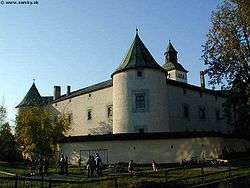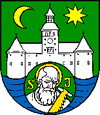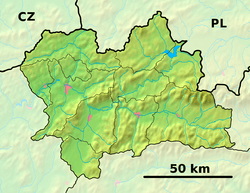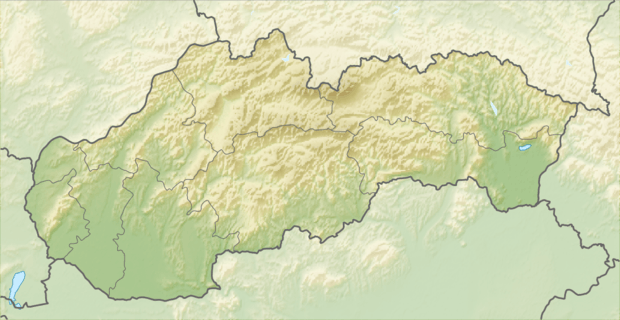Bytča
Bytča (Hungarian: Nagybiccse) is a town in northwestern Slovakia. It is located on the Váh River near the cities of Žilina and Považská Bystrica. It belongs to Upper Váh region of tourism.
Bytča | |
|---|---|
Town | |
 Bytča Castle | |
 Coat of arms | |
 Bytča Location of Bytča in Slovakia  Bytča Bytča (Slovakia) | |
| Coordinates: 49°13′27″N 18°33′51″E | |
| Country | |
| Region | Žilina |
| District | Bytča |
| First mentioned | 1234 |
| Government | |
| • Mayor | Miroslav Minárčik |
| Area | |
| • Total | 43.168 km2 (16.667 sq mi) |
| Elevation | 308 m (1,010 ft) |
| Population (2018-12-31[1]) | |
| • Total | 11,340 |
| • Density | 260/km2 (680/sq mi) |
| Time zone | UTC+1 (CET) |
| • Summer (DST) | UTC+2 (CEST) |
| Postal code | 014 01 |
| Area code(s) | +421-41 |
| Car plate | BY |
| Website | www.bytca.sk |
Etymology
The name comes from a Slavic personal name Bytek, Bytko → Bytča.[2]
History
The town arose in 1946 by a merger of the settlements Malá Bytča (including Beňov and Mikšová), Veľká Bytča and Hliník nad Váhom. The first written reference to the town's main part Veľká Bytča dates from 1234 as terra Bycha.[3] The settlement got its town charter in 1378. It was the seat of a feudal dominion and later a town with many craftsmen. In Hungarian, it was known as Biccse.
Landmarks
The town features a famous castle the Thurzó Castle built as a water castle by Pongrác Szentmiklósi in the 13th century and rebuilt in the 16th century in Renaissance style by Ferenc Thurzó. The town also houses the Wedding Palace (built by György Thurzó for his daughters' wedding) from 1601, which is the only building of this kind in Slovakia, Renaissance, Baroque and Classical bourgeoisie houses, an archive, and a museum (in the Wedding Palace).
Demographics
According to the 2001 census, the town had 11,150 inhabitants. 98.27% of inhabitants were Slovaks and 0.58% Czechs.[4] The religious make-up was 90.87% Roman Catholics, 4.35% people with no religious affiliation and 1.51% Lutherans.[4]
Economy
Today, the town is home to machine (Kinex), textile, wood processing (sports equipment), and food (brewery) industries. The brewery closed in the 2010s.
Boroughs
Bytča includes the following former villages: Psurnovice, Hrabove, Horne Hlboke, Dolne Hlboke, Hlboke nad Vahom, Benov, Miksova, Hlinik nad Vahom, Velka Bytca, Mala Bytca.[5]
Current boroughs (year of merger in brackets):
- Beňov (c. 1899 with Malá Bytča, probably Hungarian name was Banya)
- Hliník nad Váhom (1946, Hungarian: Hlinik; also called Vágagyagos between 1899 and 1919)
- Hrabové (1971; Hungarian: Hrabova; also called Rabó between 1899 and 1919)
- Malá Bytča (1946; Hungarian: Kisbiccse, German: Klein-Bitsch; also called Miksofalva from 1907 to 1919)
- Mikšová (1907 with Malá Bytča, Hungarian: Miksófalvá)
- Pšurnovice (1971; Hungarian: Psurnovicz; also called Legelővölgy between 1899 and 1919)
- Veľká Bytča (1946; Hungarian: Nagybiccse, German: Groß-Bitsch)
Notable people
- Adolf Neubauer, Jewish scholar
- Jozef Tiso (1887–1947) , Slovak priest, politician and leader of the First Slovak Republic (1939–1945) executed for war crimes
References
- "Population and migration". Statistical Office of the Slovak Republic. Retrieved 2019-04-16.
- Horňanský, Imrich (2018). "O geografických názvoch z osobných mien zo slovným základom chot-" [Geographical Names from Personal Names with Word Basis of chot-] (PDF). Slovenská reč (1): 37. ISSN 1338-4279.
- Chronológia mesta Bytča
- "Municipal Statistics". Statistical Office of the Slovak republic. Archived from the original on 2007-11-16. Retrieved 2007-12-15.
- "Partnerské mestá". bytca.sk (in Slovak). Bytča. Retrieved 2019-09-08.
Genealogical resources
The records for genealogical research are available at the state archive "Statny Archiv in Bytca, Slovakia"
- Roman Catholic church records (births/marriages/deaths): 1630-1900 (parish A)